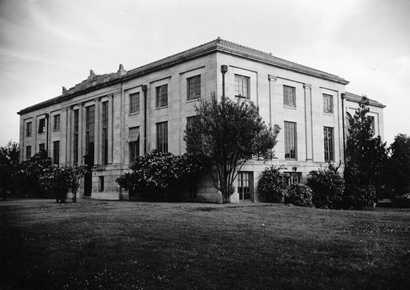|
|
"....
let us examine some of the "rest of the story."
It is true that the Civil War left San Augustine in economic depression.
Two major sources of capital investment -- slaves and land -- no longer
had value. Slavery was "gone with the wind" and few had resources
to purchase the land. But cotton gins, a gristmill, sawmills abounded..." |
The
Rev. George L. Crocket, a native of San
Augustine and also its best known twentieth-century clergyman,
published a history of San
Augustine in 1932 titled Two Centuries in East Texas. It
has become a classic. Crocket provided a detailed narrative of San
Augustine from the time of the Ais tribe, a part of the Hasini
confederacy, through post-Civil War Reconstruction, or approximately
to the beginning of his own life. A brief conclusion suggests the
notion that Crocket did not believe that much of importance happened
in San Augustine
after the Civil War.
Perhaps in a future visit we can explore the founding and nurturing
of a younger community, but this time let us examine some of the "rest
of the story."
It is true that the Civil War left San
Augustine in economic depression. Two major sources of capital
investment-- slaves and land -- no longer had value. Slavery was "gone
with the wind" and few had resources to purchase the land. But cotton
gins, a gristmill, sawmills abounded. A fire in 1890 damaged part
of the town, but rebuilding removed the scars and a new courthouse
was built.
Two newspapers, the Herald and the Saxon, were published. Townspeople
could attend five churches and patronize seven general stores and
more specialty shops. The Gulf, Beaumont, and Great Northern Railway
reached San
Augustine in 1901, and Santa Fe Railroad acquired the line two
years later. The railroad provided transportation for lumber produced
in San Augustine,
enabling an expansion in sawmilling and jobs.
By 1914 over 1,300 souls called San
Augustine home. By then they could read the Tribune or
the Cotton Belt News, talk over a local telephone exchange,
and purchase nostrums from R.N. Striplings' pharmacy. They could deposit
funds in the First National Bank and enjoy city-provided water, sewage,
and electricity services. |
 |
|
In 1927 San
Augustinians built yet another courthouse, this time a two-story
structure made of stone. Then, America entered its most significant
economic stress. "The Depression" says it all.
Businesses closed, farm products brought little revenue, and lumber
companies moved on after cutting most of the timber. Help from such
New Deal agencies as the Civilian Conservation Corps and the Works
Progress Administration saw the town through the worst of it, but
the greatest help came from a federal program for rural electrification.
This resulted in San Augustine's selection as headquarters for the
Deep East Texas Electric Co-Operative.
World War II
and postwar prosperity allowed San
Augustine to grow again. By 1990 the city counted 180 businesses,
banks, drug stores, ten churches, and a population of nearly 2,500.
And it had learned to capitalize on tourism from the attraction
of nearby lakes and its own history.
Quite a lot happened in San
Augustine in the third century beyond George Crocket's chronicle
of it.
|
All
Things Historical
March 31-April 6, 2002 column
A syndicated column in over 40 East Texas newspapers
This column is provided as a public service by the East Texas Historical
Association. Archie P. McDonald is director of the Association and
author of more than 20 books on Texas. |
|
|